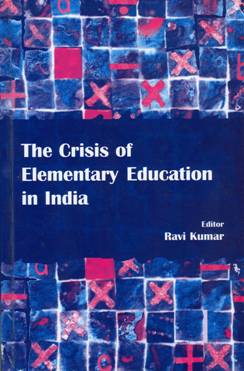|
The Crisis of Elementary Education in India Title : The Crisis of Elementary Education in India Edited by : Ravi Kumar Published by : Sage Publications Pages : 357 Price : Rs. 695/- ___________________________________________________________________________________________________________
rticle 45 of the Directive Principles of State Policy deals with the education of children till age 14, though it has been amended since, it originally read:The state shall endeavour to provide, within a period of ten years from the commencement of the Constitution, for free and compulsory education for all children until they complete the age of fourteen years. The grace period ended on the Republic Day of 1960! It is not that the government has been inactive either on the national or international front, concedes Vasudha Dhagamwar (MARG, human rights activist), one of the contributors to this compilation. Apart from its own action plans, the government has become signatory to a number of international initiatives that mentioned education as a child’s right. And yet today, the only way to sum up primary education in India – it is still in a state of CRISIS! This acute crisis is overtly manifested with a vast mass of illiterates on one hand, while on the other there is a subterranean process underway that delegitimises the role of the state as a service provider. The crisis further entrenches itself in tacit acknowledgement with the State wherein formal schooling will not be available to every child and hence, one encounters the preponderance of non-formal methods of education of a mass scale – Ravi Kumar, Associate Fellow, Council for Social Development, New Delhi, states in his introduction. In 2005 the President of India regretted the fact that only 4 per cent of the GDP was spent on education. It is not that the framers of the Constitution overlooked the school going child but they enshrined the right in Part IV in the Directive Principles of State Policy and not in Part III which would have made education a fundamental right. As part of Directive Principles of State Policy the right was non-justiceable. On 28 November 2001, observes eminent educationist, Anil Sadgopal, even as the Lok Sabha was debating the 93rd Amendment, purportedly to make education a fundamental right, 40,000 people from different parts of the country held a rally at the Ramlila grounds to protest against the Bill. Their contention? The Bill violated the principle of equality enshrined in the Constitution…………..Sub ko shiksha,samaan shiksha - was their demand. The Bill, which of course was pushed through by both Houses of Parliament, created apprehensions that it would allow the state to withdraw from its constitutional obligation under Article 45 of ensuring free and compulsory education to children till they complete 14 years of age and bring it under the obligation of parents and the community as their fundamental duty. Sadgopal quotes a newspaper report on International Literacy Day, 2004 Facing a shortage of students, the Directorate of Education has decided to close down 53 government schools, many of which are in old Delhi. This is in addition to the 55 schools already closed…….we have a steady decline in government schools…. How do you motivate marginalized parents and their children? The rural, the girl child, the girl at puberty, Dalits, children with special needs? How do you motivate teachers? If there are schools with very few children on the verge of closure there are also populous schools with ridiculous teacher/student ratio. Several of these issues have been addressed in the volume as it examines policy, legal obligations, economic implications, gender and inclusive education. Education is said to be the single most important agenda in the context of development today, tomes have been written on education policies, several policies have been framed, thousands of hours have been expended on seminars, debates and other forums round the world – India has been a most enthusiastic signatory to various declarations on child’s right to education – yet we have one of the largest populations of non-school going children in the developing world. About time we identified practical solutions and got down to teaching our teeming under fourteens, there is no time for indulging in rhetoric – enough time has been lost, we have raised too many uneducated adults. q
|
